Family Anatidae
Subfamily: Dendrocygninae
One pantropical genus, of distinctive long-legged
goose-like birds
Genus: Dendrocygna,
whistling ducks (9 living species)
The whistling ducks or tree ducks are a subfamily,
Dendrocygninae of the duck, goose and swan family of
birds, Anatidae.
Dendrocygna, is from latin, and
translated to english it is something like 'treeswans'.
This because they often are found
resting in trees.
It contains only one genus, Dendrocygna, containing eight
living species These species have a worldwide distribution
through the tropics and subtropics. These ducks have, as their
name implies, distinctive whistling calls.
The whistling ducks have long legs and necks, and are very gregarious,
flying to and from night-time roosts in large flocks.
Both sexes have the same plumage, and all have a hunched appearance
and black underwings in flight.
http://en.wikipedia.org/wiki/Whistling_duck
|
Spotted
Whistling-Duck, Dendrocygna
guttata, No: Perleplystreand
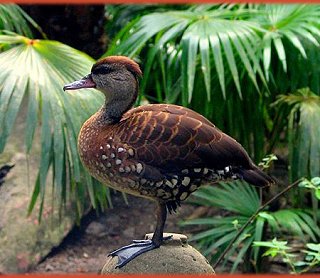
Photo: Viajar24h.com
http://commons.wikimedia.org/wiki/File:Birds_www.photo.org.es-30.jpg
Its range is the Philippines
south through central Indonesia
to New Guinea. It has recently colonised Australia, with a small
population now resident at Weipa on the western coast of Cape York
Peninsula. See map below.
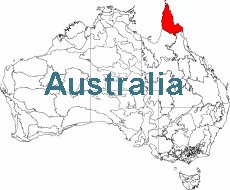
It is seen in lakes with emerging aquatic
vegetation, such as grass.
This bird is gregarious. In nature it is common to see it
in flocks counting in the hundreds. It associates with the
Wandering Whistling-Duck, Dendrocygna arcuata.
Nesting is done in holes in trees. A clutch with eleven eggs is
registered. Incubation takes 31 days.
It is possible that both parents incubate.
This is one of the larger whistling-ducks. The adults of this species
reach a length from 43 to 50 cm.
The average weight is about 800 grams.
The Spotted Whistling-Duck in Spanish is called “Yaguasa Moteada”.
http://www.damisela.com/zoo/ave/otros/anser/anatidos/yagua/guttata/indexe.htm
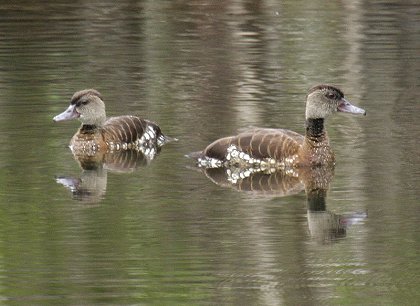
The
Spotted Whistling Duck, Dendrocygna guttata, Lockhart River,
Cape York. Dec.r 2008
Photo: Aviceda
http://en.wikipedia.org/wiki/File:Spotted_whistling-duck_lockhart08.JPG
The Spotted Whistling Duck is spread over
a large area between 100,000 to 1,000,000 km².
It has a rather large global population estimated between 10,000
and 25,000 ducks.

Spotted whistling duck,
Dendrocygna guttata
BBC Natural History Unit
www.arkive.org
Plumed
Whistling-Duck, Dendrocygna
eytoni, No: Prydplystreand

©
www.arthurgrosset.com
The Plumed Whistling Duck, Dendrocygna eytoni, also
called the Grass Whistle Duck or Eaton's tree-duck, is a whistling
duck which breeds in New Guinea and Australia. It is a predominantly
brown-coloured duck with a long neck and
characteristic plumes arising from its flanks. The sexes are
similar in appearance
Described by English naturalist Thomas Campbell Eyton in 1838,
its specific epithet honours its namer. Its generic name is
derived from the Ancient Greek terms dendron "tree",
and kuknos (via Latin cygnus) "swan". Alternate common
names
include; Eyton's Plumed, Red-legged or Whistling Tree-duck,
and Grey or Red-legged Whistler
http://en.wikipedia.org/wiki/Plumed_Whistling_Duck
|

Photo:
Glen Fergus
http://commons.wikimedia.org/wiki/File:Plumed_Whistling-Duck_swimming.jpg
Measuring 42–60 cm and weighing around a
kilogram, it is a long-necked duck with brown upperparts, paler
underparts
and a white rump. The chest is chestnut with thin black bars,
while long black-margined plumes arise from its flanks.
Its bill and legs are pink, and its iris is yellow. The male
and female are similar in appearance.
The species has a characteristic lowered neck and short, dark,
rounded wings while flying.
The call is a characteristic whistle which gives the bird its
common name
http://en.wikipedia.org/wiki/Plumed_Whistling_Duck
|

Prydplystreand,
Dendrocygna eytoni, June,
2008
Photo:
Glen Fergus
http://en.wikipedia.org/wiki/File:Plumed_Whistling-Ducks.jpg
The range is eastern, northern and central Australia
from the Kimberley across the Top End and Cape York, down to
southern Queensland and northern New South Wales on the east
coast, although may reach northwestern Victoria inland,
in the vicinity of the Murray River. It is also found in New
Guinea. The preferred habitat is tall grassland and savanna,
often near bodies of water.
Rather than diving for food in bodies of water like other ducks,
the Plumed Whistling Duck feeds by cropping grass on land.
The Plumed Whistling Duck breeds during the wet season, generally
in January to March, although it can be later in April or,
in a few cases, May. One brood is raised per season. The nest
is a mattress of grasses or similar material in tall grass,
or in or near vegetation as cover. 10 to 12 oval eggs are laid,
measuring 48 x 36 mm; 14 or more have been recorded on
occasion. Initially shiny and creamy-coloured, they may become
stained. The incubation period is around 30 days.
http://en.wikipedia.org/wiki/Plumed_Whistling_Duck
|
Fulvous
Whistling-Duck, Dendrocygna
bicolor, No: Brunplystreand

A Fulvous Whistling Duck, Photo taken
in Wilhelma, Stuttgart, 2004-08-07
Foto: Branko
Kannenberg
http://no.wikipedia.org/wiki/Fil:Dendrocygna_bicolor_wilhelma.jpg
The Fulvous Whistling Duck, Dendrocygna bicolor,
is a whistling duck which breeds across the world's tropical
regions
in much of Central and South America, Sub-Saharan Africa, the
Indian subcontinent, and the Gulf Coast of the United States.
The Fulvous Whistling Duck is a common but wary species. It
is largely resident, apart from local movements, but vagrancy
has occurred to southern Europe. It nests on a stick platform
in reeds, laying 8–12 eggs, but hollow trees or old bird
nests
are occasionally used for nesting.
Its habitat is freshwater lakes, paddy fields or reservoirs
with plentiful vegetation, where this duck feeds mainly at
night on
seeds and other parts of plants..
|
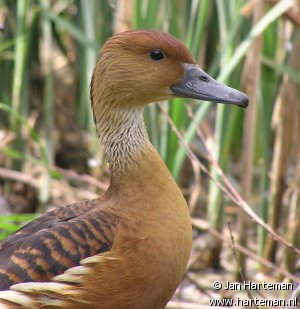
|
The Fulvous Whistling Duck is 48–53 cm long. It has
a long grey bill, long head and longish legs, buff head and
underparts,
the latter reddish-tinged on the flanks, a dark crown, and
dark grey back and wings. The tail and wing patches are chestnut,
and there is a white crescent on the upper tail which is visible
in flight.
All plumages are similar, except that juveniles have less
contrasted flank and tail colouration.
This species is gregarious, and at favoured sites substantial
flocks can form. As the name implies, these are noisy birds
with a clear whistling kee-wee-ooo call.
This duck are widespread, over more than 10,000,000 km².
The global population is estimated to 1,300,000-1,500,000
ducks.
|

Fulvous
Whistling-Duck,
2006-02-10
Photo: Duncan
Wright
http://commons.wikimedia.org/wiki/File:Fulvous_whistling_duck.JPG
Wandering
Whistling-Duck,
Dendrocygna
arcuata,
No:
Hetteplystreand

Hetteplystreand, Melbourne Zoo
Photo: Fir0002, flagstaffotos.com.au
http://commons.wikimedia.org/wiki/File:Wandering_Whistling_Duck_-_melbourne_zoo_cropped.jpg
The
Wandering Whistling-Duck, Dendrocygna
arcuata,
inhabit tropical and subtropical Australia,
the Philippines,
Indonesia,
Papua New Guinea and the Pacific
Islands.
There are three subspecies:
Dendrocygna
arcuata arcuata, Indonesia
Dendrocygna
arcuata australis, Australia
Dendrocygna
arcuata pygmaea, New Britain (Bismarck øygruppen)n
Formerly named Tree Ducks, the Wandering Whistling Duck have their
new name because
of their loud whistling calls and the whistling noise their wings
make during flight.
They have long necks and legs and look like a cross between a goose
and a duck.
They have a strong head and neck with a darker crown and hindneck.
The breast contains black spotting and the feathers are mostly dark
brown.
They range in size from 54–60 cm in height and weigh on average
750 grams.
They mainly feed on grasses, waterlillies, water plants and occasionally
insects and aquatic vertebrae.

The Wandering Whistling Duck lives in deep lagoons, flooded grasslands
or dams.
They enjoy the water and rarely leave the shore. They can swim and
dive with ease.
Breeding occurs during the tropical wet season usually between
December and May.
During this time six to fifteen eggs are laid in a nest not far
from water and usually in high grass or a sheltered area.http://www.avianweb.com/wanderingwhistlingducks.html

Lesser
Whistling-Duck, Dendrocygna
javanica, No: Småplystreand

Lesser Whistling-Duck, Dendrocygna
javanica, in Kolkata, West Bengal, India. 2.2.2007
Photo:
J.M.Garg
http://en.wikipedia.org/wiki/File:Lesser_Whistling-duck_(Dendrocygna_javanica)-_after_bath_at_Kolkata_I_IMG_2480.jpg
The
Lesser Whistling Duck, Dendrocygna javanica, also known
as Indian Whistling Duck, is a small whistling duck
which breeds in South Asia and southeast Asia. It may also be
called the Lesser Whistling Teal (based on an older
classification), or the Tree Duck.
This is a largely resident species distributed unevenly from
the Pakistan lower river valleys eastwards across most of
peninsular India, Nepal terai, Sri Lanka, Bangladesh, Burma,
Thailand, Malaysia, Singapore, Indonesia, south China,
to Vietnam. It is largely resident, apart from local movements
(often induced by drought or floods), but Chinese birds
winter further south.
Covering up to 10 million km², it is estimated to have
a global population of between two and twenty million individuals.
Habitat: still freshwater lakes, with plentiful vegetation,
where this duck feeds on seeds and other vegetation.
Occasionally seeks refuge in the ocean just outside the surf
area.
May be seen often perching on trees near water bodies, giving
rise to the alternate name Tree Duck. |

Lesser
Whistling-Duck,
Dendrocygna javanica
Photo:
coracii
http://www.flickr.com/photos/36207186@N00/773396667/
This species has a long grey bill, long head
and longish legs. It has a buff head, neck and underparts, and
a darker crown.
The back and wings are darkish grey, and there are chestnut
patches on the wings and tail. All plumages are similar.
This species is gregarious, and at favoured sites, such as Carambolin
Lake in India, the flocks of a thousand or more
birds arriving at dawn are an impressive sight. |
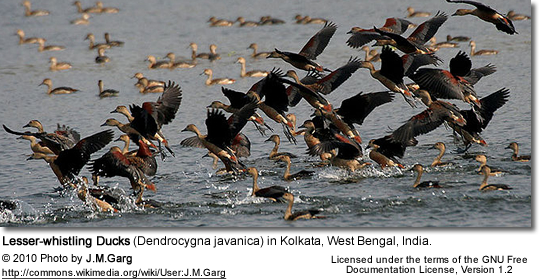
The call is a wheezy, whistling "seasick, seasick", call,
uttered in flight. Roosts can be quite noisy.
It nests in tree holes, old nests of other birds, or on a stick
platform near the ground, and lays 6-12 eggs.
Read
more about the Lesser Whistling Duck in Thailand here.
White-faced
Whistling-Duck, Dendrocygna
viduata, No: Maskeplystreand

©
www.arthurgrosset.com
The White-faced Whistling Duck, Dendrocygna
viduata, is a whistling duck which breeds in sub-Saharan
Africa and
much of South America.
This species is gregarious, and at favoured sites, the flocks
of a thousand or more birds arriving at dawn are an
impressive sight. As the name implies, these are noisy birds
with a clear three-note whistling call. |
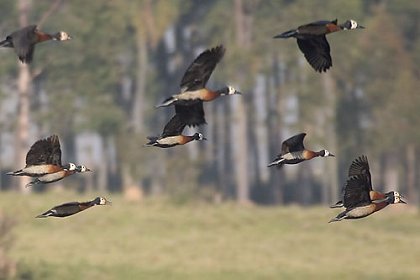
©
www.arthurgrosset.com
This species has a long grey bill, long head and
longish legs. It has a white face and crown, and black rear
head.
The back and wings are dark brown to black, and the underparts
are black, although the flanks have fine white barring.
The neck is chestnut. All plumages are similar, except that
juveniles have a much less contrasted head pattern. |
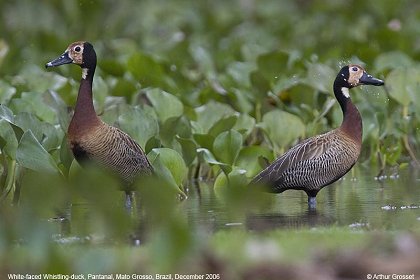
White-faced
Whistling Duck,
Pantanal, Mato Grosse, Brazil, Dec.2006
©
www.arthurgrosset.com
The habitat is still freshwater lakes or reservoirs,
with plentiful vegetation, where this duck feeds on seeds and
other plant food.
This is an abundant species. It is largely resident, apart from
local movements which can be 100 km or more.
It nests on a stick platform near the ground, and lays 8-12
eggs. Trees are occasionally used for nesting.
Text for this bird: http://en.wikipedia.org/wiki/White-faced_Whistling_Duck |
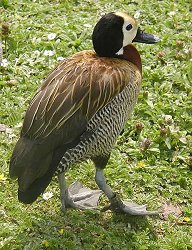
White-faced Whistling Duck at Slimbridge Wildfowl
and Wetlands Centre, England, June 2003
Photo: Adrian
Pingstone
http://en.wikipedia.org/wiki/File:White.faced.whistling.duckARP.jpg
West
Indian Whistling-Duck, Black-billed - Cuban- W-D, Dendrocygna
arborea, No:Palmeplystreand
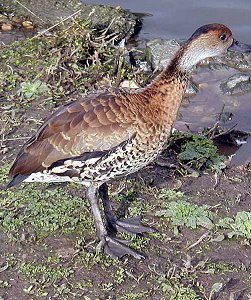
West
Indian Whistling-Duck,
ved Slimbridge
Wildfowl and Wetlands Centre, England. Feb. 2004
Photo:
Adrian Pingstone
http://en.wikipedia.org/wiki/File:Black-billed.wh.duck.arp.500pix.jpg
The West Indian Whistling Duck, Dendrocygna
arborea, is a whistling duck which breeds in the Caribbean.
Alternative names are Black-billed Whistling Duck and Cuban
Whistling Duck.
The West Indian Whistling Duck is widely scattered throughout
the West Indies including a large breeding population
in the Bahamas, and smaller numbers in Cuba, the Cayman Islands,
Antigua and Barbuda, and Jamaica.
It is largely sedentary, apart from local movements which can
be 100 km or more. Nests have been reported in tree cavities,
on branches, in clumps of bromeliads, and on the ground under
thatch palms and other dense bushes.
The usual clutch size is 10-16 eggs. It habitually perches in
trees, which gives rise to its specific name. |

The
Royal Palm
1) Photo: Wilder Mendez 2) US Forest
Service photo 3) Photo: Lezumbalaberenjena
The birds are mostly nocturnal and secretive,
inhabiting wooded swamps and mangroves, where this duck roosts
and feeds on plant food including the fruit of the Royal
Palm.
The West Indian Whistling Duck is the largest (48-58 cm) and
darkest of its genus. It has a long black bill, long head and
longish legs. It has a pale foreneck and light brown face. The
crown, back, breast and wings are dark brown to black,
and the rest of the underparts are white with heavy black markings.
All plumages are similar, except that juveniles are duller and
have a less contrasted belly pattern. |
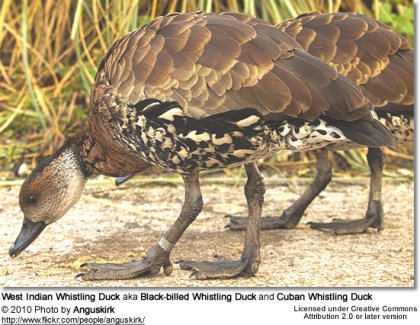

West
Indian Whistling-Duck,,
Dendrocygna javanica, in Kolkata, West Bengal, India. 2.2.2007
Photo:
J.M.Garg
http://en.wikipedia.org/wiki/File:Lesser_Whistling-ducks_(Dendrocygna_javanica)_at_Kolkata_I_IMG_2447.jpg
The West Indian Whistling Duck has suffered extensive hunting for
its eggs and for sport (Why is this called a 'sport'?).
Wetlands are a very limited habitat in the Caribbean, with continuing
conversion for development and agriculture.
More than 50% of remaining wetlands are seriously degraded by the
cutting of mangroves and swamp-forest, pollution
(especially over-use of pesticides1) and natural
catastrophes such as droughts and hurricanes. Predation is inadequately
documented but may be a factor.

West Indian
whistling-duck (Dendrocygna arborea
Jurgen Hoppe, Website: http://www.caribemotion.com
www.arkive.org
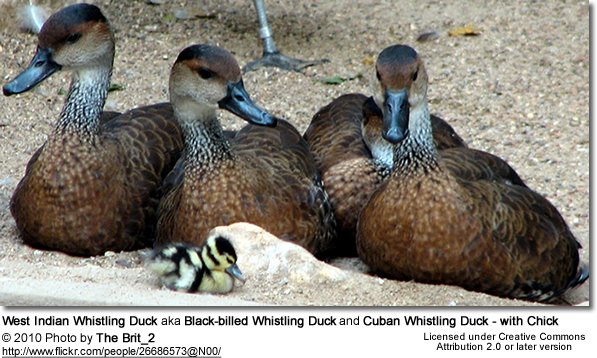
Black-bellied
Whistling-Duck, Dendrocygna
autumnalis,
No:Rødnebbplystreand
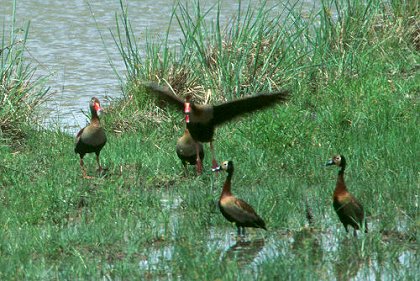
Black-bellied
Whistling-Duck,
Dendrocygna autumnalis discolor
It is easily identified with its red bill and legs,
grey head, brown neck and back and black belly.
The subspecies Dendrocygna autumnalis discolor
which is seen on this photo differs from the nominate subspecies
in having a grey breast band between the brown neck and the black
belly.
Flocks do not mix with viduata or other ducks" but as
can be seen in this photo, small groups do
mix with White-faced Whistling-ducks.
©
www.arthurgrosset.com
The Black-bellied Whistling Duck, Dendrocygna autumnalis,
formerly also called Black-bellied Tree Duck, is a whistling
duck that breeds from the southernmost United States and tropical
Central to south-central South America.
In the USA, it can be found year-round in parts of southeast
Texas, and seasonally in southeast Arizona, and
Louisiana's Gulf Coast. It is a rare breeder in such disparate
locations as Florida, Arkansas, Georgia and South Carolina.
It is widely known as pijije (also pixixi or pichichi), chiriría
or sirirí in Latin America, though this can also refer
to other
whistling-ducks and a qualifyer such as ala blanca or aliblanco
("white-winged") is usually added to signify this
species.
In Mexico, it is also called pato maízal ("cornfield
duck") due to its habit of visiting such fields after harvest.
And since it is one of only two whistling-duck species native
to North America, it is occasionally just known as the
"whistling duck" in the southern USA.
The Black-bellied Whistling Duck is an unusual species among
North American waterfowl. With its long legs, peculiar
appearance and odd habits, it was described by one early American
ornithologist[who?] as "most un-duck-like".
Its numbers are increasing in North America.
|

Black-bellied
Whistling-Duck,
Pantanal, Mato Grosse, Brazil, Dec.2006
©
www.arthurgrosset.com
The Black-bellied Whistling Duck is 48–53 cm long. It
has a long red bill, long head and longish legs, pale grey head
and
mostly grey-brown plumage. The belly and tail are black, and
the body plumage, back of the neck and cap are a rich
chestnut brown. The face and upper neck are grey, and they sport
a thin but distinct white eye-ring.
The extensive white in the wings is obvious in flight, less
so on the ground; it is formed by the secondary remiges while
the primaries are black; the wing-coverts are brown. Males and
females look alike; juveniles are similar but have a grey
bill and less contrasting belly. |

Black-bellied
Whistling-Duck,
Aguas de São Paulo, Brazil, Dec. 2006
©
www.arthurgrosset.com
Due to its unique appearance, this species is almost unmistakable.
With an upright stance, long pink legs, and long neck,
adult Black-bellied Whistling Ducks are unlikely to be confused
with any other bird within their range.
The wing bar is in fact unique among living whistling ducks.
But when on the ground, it may be hard to discern
or look like the light flanks present in many of these waterfowl. |
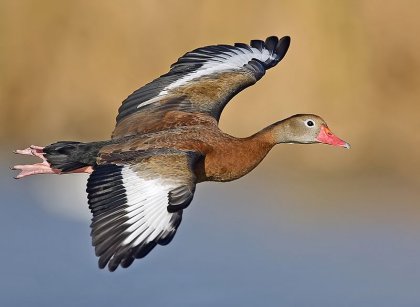
Black-Bellied Whistling Duck, Birding
Center, Port Aransas, Texas
Photo:
Alan D. Wilson
http://en.wikipedia.org/wiki/File:Whistling_duck_flight02_-_natures_pics-edit1.jpg
The Black-bellied Whistling Duck is a common
but wary species. It is highly gregarious, forming large flocks
when not
breeding, and is largely resident apart from local movements.
It usually nests in hollow trees. The habitat is quiet shallow
freshwater ponds, lakes, and marshes, cultivated land or reservoirs
with plentiful vegetation, where this duck feeds mainly
at night on seeds and other plant food. Tree-lined bodies of
water are of particular value and as the old common name
suggests, they are quite fond of perching in trees. This species
can also be seen "loafing" (doing nothing in particular
except hanging around and socializing) in flocks on golf courses
and other grassy areas near suitable waterways.
Feeding often occurs nocturnally, but they can be encountered
eating at any hour of the day.
Black-bellied Whistling Ducks ingest a wide variety of plant
material, but also consume arthropods and aquatic
invertebrates when available. They often feed on submerged vegetation
by wading through shallow water.
As its Mexican name implies, it is commonly seen gleaning recently-harvested
fields for leftover seed and invertebrates
brought up by the harvesters disturbing the soil.
The Black-bellied Whistling Duck is mainly non-migratory. |
|





































